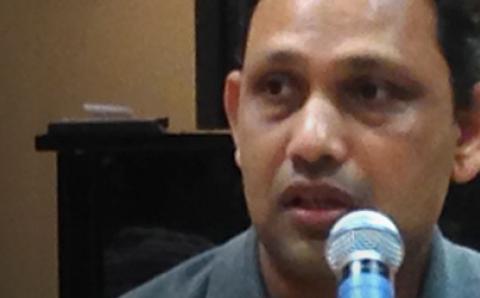Arriving at the Gerald R. Ford airport in my hometown of Grand Rapids, Mich., from a recent trip, I struck up a conversation with my taxi driver.
I asked him what country he was from. “Ethiopia,” he said. Then I asked if he happened to be part of a church. He immediately replied that he was part of the Ethiopian Orthodox Church. From my ecumenical experience, I’ve known that this is one of the larger churches in the world with an amazing history in the country of Ethiopia. But I was puzzled by its presence in Grand Rapids, so I asked my driver where he worshiped.
“We built a church on 28th Street,” he replied. “And we have a priest from Ethiopia who serves us. His job is to constantly pray. We—the other Ethiopian Orthodox parishioners in Grand Rapids—support him. In fact,” my driver continued, “today it is my turn to bring him his breakfast, lunch, and dinner.”
A few months ago I attended a conference in Quito, Ecuador, for North American and Latin American church leaders on the theme “Faith, Economy, and Migration.” I gave a presentation on my recent book, From Times Square to Timbuktu: The Post-Christian West Meets the Non-Western Church. This was followed by a paper given by an official of the Ecuadorian government, Julian Guaman Gualli, on immigration trends in his country.
Mr. Guaman Gualli was intent on talking with me after the session. He is from the indigenous population of Ecuador—groups that traditionally have been located in the Andes and also in the remote Amazonian regions of the country. In a famous story of martyrdom known throughout the evangelical world and beyond, five U.S. missionaries who attempted to establish relationships with one of these tribes in the Amazon were killed in 1956. Subsequently others, including the widow of one of those killed, continued their efforts, resulting eventually in many of those tribal groups converting to Christianity.
Mr. Guaman Gualli was fascinated and excited by the picture of the religious impact of immigration to North America I had presented. He told me that he was a member of the Evangelical Church in Ecuador and that there were at least six congregations, including his own indigenous tribal group and others—metizos—who had established “intercultural” congregations worshiping in New York and Chicago.
At the Pentecostal World Conference held last year in Kuala Lumpur, Malaysia, I was part of a delegation from Global Christian Forum joining about 3,700 Pentecostals from around the world. We heard some of the world’s best-known Pentecostal preachers, including some unknown in North America.
We listened, for instance, to Rev. Enoch Adeboye, head of the Redeemed Christian Church of God. Founded in Nigeria in 1952, this church is representative of “African Instituted Churches”—denominations begun not by Western missionaries but by indigenous African leadership, often stressing uniquely African cultural characteristics.
The Redeemed Christian Church of God now has an estimated 5 million members in 147 countries, including 720 congregations in the U.S. Its U.S. headquarters is in Floyd, Texas, a town north of Dallas that is home to about 220 people. The Redeemed Christian Church of God has built a worship pavilion to hold the 10,000 people who come for revival meetings and other services. Its U.S. director, Pastor James Fadele, says, “Because heaven is real, God is real. And that is why we want to plant churches like Starbucks.”
I’m told that the late Gerald R. Ford once said that immigration—specifically, the economic need of society for work to be done by those who are here illegally from other countries—was one of the most perplexing problems he faced as president. Since then we have witnessed intensified political debate on this topic in the U.S.
What has been missing from this national debate, however, has been attention to the impact of immigration on the character and vitality of religious practice in our society. Immigration has already reshaped America’s religious landscape in ways we have barely begun to understand. Further, the future nature and vitality of the churches in North America and their relationship to the dramatically changing patterns of world Christianity will be determined largely by our response to the impact of immigration.
The new dimension of our contemporary story, however, is that such immigration is occurring at the same time world Christianity has been undergoing unprecedented changes in its geographical presence. The dramatic shift in world Christianity’s “center of gravity” has been well studied and documented. A few facts bring this into focus:
- For 1,000 years, Christianity’s center of gravity remained in Europe. Then, from 1910 to 2010, it moved from Spain to a point near Timbuktu, Africa—the most rapid geographical shift in Christian history.
- By 1980, more Christians were living in the global South than the global North—for the first time in 1,000 years.
- In 1910, 2 percent of Africa’s population was Christian. Today, one of four Christians in the world is African.
- Latin America and Africa now hold 1 billion of the world’s Christian community, and the numbers continue to grow.
- By 2025, Asia’s present 350 million Christians are projected to increase to 460 million.
- In the last decade, Islam has grown in Asia by 1.7 percent, while Christianity has grown by 2.4 percent.
- On any given Sunday, there are probably more people attending worship services in China than in the U.S.
Statistics like these paint a changing geographical picture of world Christianity. But these changes have to do with far more than just geography. Christianity has now emerged as a non-Western religion. Its dominant expressions are growing today outside the familiar home of Western culture shaped by the Enlightenment. We are witnessing today the spiritual resurgence of non-Western Christianity.
With this come expressions of Christian worship and practice that focus more on experience and on all the senses, rather than those forms that are more rationalistic. This cuts across denominational traditions.
The most dramatic evidence of this movement is the astonishing rise of Pentecostalism. Modern Pentecostal history, at least in the U.S., is usually dated to the Azusa Street revival in Los Angeles a little more than a century ago. The explosive growth of Pentecostalism around the world in the last century, along with the religious transformation of the African continent, are the two most compelling narratives of Christian history in the 20th century, and each continues today.
One of every four Christians in the world is Pentecostal or charismatic. (“Charismatic” refers to those who exhibit Pentecostal gifts and practices but belong to non-Pentecostal denominations.) One of four Pentecostals is Asian, and 80 percent of Christian conversions in Asia are to Pentecostal forms of Christianity. One of three Pentecostals is in Africa. In Latin America, Pentecostalism is growing at three times the rate of Roman Catholicism.
Globally, Pentecostalism is growing at four times the overall rate of Christianity’s growth. Think of it this way: one of every 12 people alive today is Pentecostal. For a movement generally regarded as only about a century old, this is an astounding religious development.
Therefore, the dramatic shift of world Christianity to the global South is accompanied by the rapid growth in forms of Christian practice that place a strong emphasis on religious experience as well as the cohesive value of Christian community. These expressions of faith are full of spiritual vitality, and they are highly contextualized to local culture.
This is what makes the religious impact of immigration on North American society so fascinating and crucial, especially for the life and witness of its Christian communities. The global trends that are reshaping the future of world Christianity can be reflected in local dialogues and encounters even within our congregations.
The 2010 census suggests that there were 43 million foreign-born residents in the U.S. Of these, 74 percent were Christian, 5 percent were Muslim, 4 percent were Buddhist, and 3 percent were Hindu. The overwhelming religious impact of recent immigration to the U.S. has been on the Christian community.
Hispanic immigration is radically transforming the U.S. Roman Catholic church. Today one of three U.S. Catholics is Hispanic, and this population has accounted for 71 percent of the growth in the Catholic Church since 1960. In some major metropolitan areas such as Los Angeles, 70 percent of Catholics are Hispanic.
This is not just about numbers. Hispanic Catholics bring forms of Catholic piety and practice that reflect the enculturation of Christianity in Latin America. It’s estimated that 54 percent of Latino Catholics identify themselves as charismatic, incorporating the practices of speaking in tongues, spiritual healing, and gifts of the Holy Spirit common in Pentecostal circles.
However, the 23 percent of the U.S. Hispanic population who are Protestant are also having an impact. There are about three times as many Latino Protestants in the U.S. as there are Episcopalians. The vast majority are evangelical or Pentecostal, often found in the storefront churches and chapels that dot Hispanic neighborhoods in U.S. and Canadian cities and towns.
Some Hispanic Christians are drawn to the theology and organizational resources offered by existing Protestant denominations, including the Christian Reformed Church and the Reformed Church in America, among others. The vibrant spiritual experience and generally conservative theology of Latino Protestants is often combined with strong commitments to social solidarity and justice.
Primarily because of birth rates, the Hispanic population in the U.S. is projected to pass 100 million by 2050. Among other consequences, this means that Hispanic Catholic and Protestant congregations and movements will become a defining feature in American Christianity.
The 2010 U.S. census placed the Asian-American population at 17.3 million. During the previous decade, this population grew by 46 percent—faster than any other racial group—and is expected to reach 40 million by 2050. Sociologists of religion estimate that 44 percent of Asian-Americans are Christian, often reflecting significantly higher percentages than the Christian populations within their various homelands. The impact of their deep piety, such as the intense commitment of Korean Christians to prayer as well as to theological study, is being experienced throughout much of the American church. Of the roughly 5,000 students at Fuller Theological Seminary, for instance, over 1,000 are Asian or Asian-American.
In addition, the missionary commitment of many Asian Christian communities has an impact even in the U.S. While at the 10th World Council of Churches Assembly in Korea last November, I learned that in 1981 Korean churches sent 511 missionaries to various countries around the world. In 2012 they sent 24,742 missionaries to 169 nations, including the U.S.
Immigration from Africa has increased dramatically over the past 50 years. When John F. Kennedy was inaugurated as president in 1960, only 35,355 African-born residents were living in the U.S. A half-century later, that number had grown to 1.5 million. The vast majority of these are Christians, many coming from Nigeria, Ghana, Kenya, or other African countries that have experienced the rapid growth of Christianity over the past century.
Many of these Christian immigrants bring a spiritual fervor and missionary zeal that has been forged in non-Western cultures within the African continent. As author Jehu Hanciles reminds us, “Every Christian migrant is a potential missionary.” They bring to North America the texture and expressions of Christian faith and practice that are having a dramatic impact on shaping the future of world Christianity.
But where do immigrants worship? For all kinds of obvious reasons, many immigrants are drawn to congregations comprised of those like themselves. They join with others from their country of origin and from their particular denominational affiliation in monocultural congregations. In the midst of all the challenges of adapting to life in a new culture, such a congregation becomes a place of security, strength, and affirmation of identity.
But that is not the only option, and often there are generational differences. Many immigrants are drawn to congregations that are multiracial and in which they are a minority. The question, always, is whether such congregations learn the practice of radical hospitality that allows them to be genuinely transformed by the presence of those who, in biblical words, are “sojourners and strangers in the land.”
The challenge of developing multiracial congregations—that is, churches where at least 20 percent of the group is from a racial-ethnic background different from the majority—is arduous. Statistics compiled from national studies in 2008 indicate that of the estimated 350,000 congregations in the U.S., only about 7 percent met that definition of being multicultural.
But in recent years, the commitment to this vision of congregational life has deepened with expanding resources, networks, conferences, and inspiring examples. The Vineyard Church in Columbus, Ohio, for example, includes immigrants and refugees from 104 nations comprising 28 percent of its 9,000 members. Recently Michael O. Emerson of Rice University, one of the leading authors on and researchers of multiracial congregations, has documented a marked increase in those congregations from 7 percent of U.S. congregations in 2008 to 13.7 percent today. That trend is significant because multiracial congregations are often the portals through which the unique experiences and perspectives of immigrants shaped by non-Western Christianity are shared with others at local expressions of the church.
So, through the unanticipated patterns of modern migration, world Christianity has come to our doorstep.
The dialogue between traditional Western Christianity and emerging non-Western expressions of faith has become critical. There is no more important ecumenical challenge today. And because of global migration, that interchange now can take place in communities and congregations close to home—as the post-Christian West meets the non-Western church.
Web Questions:
- “Immigration has already reshaped America’s religious landscape in ways we have barely begun to understand,” says author Wesley Granberg-Michaelson. What are some examples of how immigration is reshaping religious practice in North America?
- The author suggests that immigrants bring expressions of Christian worship and practice that focus more on “all the senses.” How is this similar to or different from worship in your own congregation?
- How might the global trends that are reshaping the future of world Christianity be reflected in local dialogues and encounters within our congregations?
- How willing are we to practice the kind of hospitality that allows us to be transformed by the presence of those who are “sojourners”? What are some of the fears that might keep us from being less than hospitable?
- What does the arrival of “world Christianity” in North America mean for the kingdom of God?
About the Author
Wes Granberg-Michaelson served as general secretary of the Reformed Church in America from 1994 to 2011. He’s the author of eight books, including Future Faith: Ten Challenges Reshaping Christianity in the 21st Century (Fortress) and most recently How Change Comes to Your Church (Eerdmans). He and his wife now live in Santa Fe, N. Mex.









